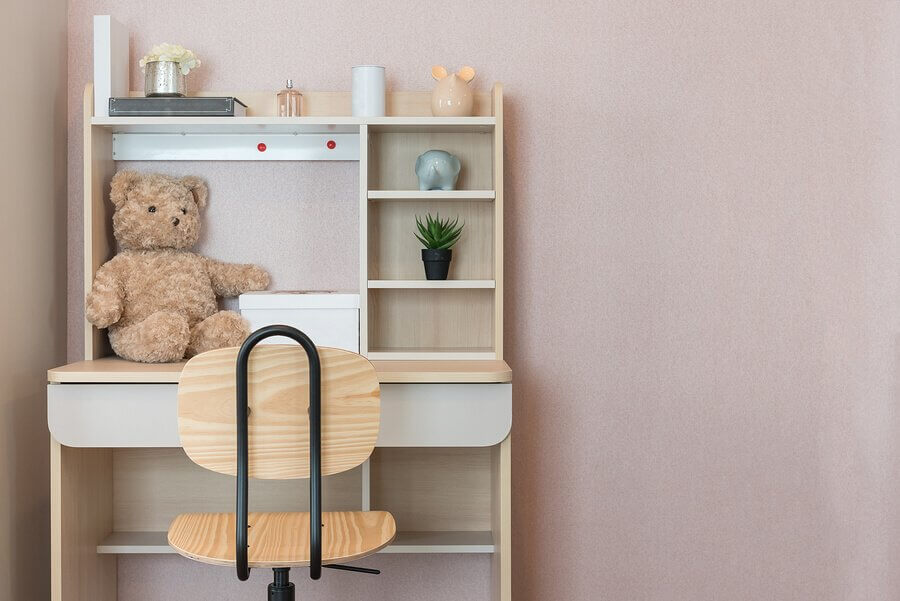5 Ideas for Creating a Study Room for Your Kids

From an early age, it’s important for parents to encourage their children to learn certain habits that support their education and organization skills. Providing a study room for your kids is an ideal way to help them concentrate and dedicate time to doing their school work.
As children grow up, they have more and more responsibilities, above all when they start school. Once this academic phase begins, they’ll have daily homework, as well as projects or exams.
To do all this, it’s important to have a place where they can concentrate to do their work. A study room for your kids is the best option.
Creating an ideal space for your child to study is important. When you design it, keep in mind these guidelines so the room has everything necessary for a pleasant environment which is also comfortable and distraction-free.
First, make sure you know the dimensions of the space you have available, and choose where this study space will be. While you do this consider some guidelines for organizing a study room for your kids.
5 Ideas for Creating a Study Room for Your Kids
1.Choosing and Organizing a Desk
First of all, to create a study room for your kids, you’ll need to choose a desk where they’ll do their work. Choosing the furniture will depend somewhat on your personal taste, much like the decoration.
Look for a desk that is large, with drawers to store all your child’s school supplies. This could include tools, paper, dictionaries, etc. This will help your child to have everything within reach, avoiding distractions when it comes time to study.

The desk should be organized so that when your child sits down to study, the desk always feels organized. For example, have a specific place to keep pencils and books.
Being responsible for organizing the room is a great way to create good habits for your child. They can clean the room on their own as a daily chore.
2. Choosing a Location for the Desk
Choose a location for the desk where there is good lighting. Take advantage of natural light, and make sure your child doesn’t have to squint to read. It’s also a good idea to have a desk lamp for studying when there isn’t enough natural light.
3. Another Key Element: The Chair
Like the desk, which should be appropriate for school work, the chair should be ergonomic and good for the spine.
The chair should be comfortable, but should also support good posture. This is vital for helping your child keep a straight spine. Good posture will also help your child avoid the muscle tension that can harm their vertebrae.
In addition to all that, it’s also important to find a chair that works for your child’s needs. With a good chair they’ll be able do their work with better concentration and dedication.
“It’s important to create an ideal space for your child to study in”
4. Create a Separate Space
As much as possible, it’s essential to divide study space from play space. This is important for setting your child up for optimum cognitive development and discipline.
On the one hand, the study room is associated with responsible, organized behavior. This will help your kid to concentrate to be able to successfully complete their work and better develop their abilities.
On the other hand, in the play area your child will be able to freely enjoy themselves and create their own activities. Having a play area as well as a study area supports development of imagination, creativity, and inventiveness.

5. Should the Computer be in the Play Room or the Study Room?
You must be clear and firm when your child is studying and wants to use the computer. It should be used only for academic purposes, whether doing research or practicing certain skills, like a foreign language.
Using a computer for fun is fine, as long as an adult is monitoring it. Keep in mind these important points:
- First, limit computer time. It isn’t good for kids to spend hours in front of a computer.
- Second, monitor the content that your child has access to. This is for their safety.
Creating a study room for your kids or providing a good environment for doing school work will be fundamental in teaching them values. You’ll teach them responsible habits that will last a lifetime.
All cited sources were thoroughly reviewed by our team to ensure their quality, reliability, currency, and validity. The bibliography of this article was considered reliable and of academic or scientific accuracy.
- Cortese, A. (2011). Técnicas de estudio. Metodología de la investigación.
- Narváez, M. R. T., Guzmán, I. T., González, M. D. C. U., & Robayo, A. M. M. (2009). Hábitos de estudio vs. fracaso académico. Revista educación, 33(2), 15-24. https://www.redalyc.org/pdf/440/44012058002.pdf
- Ramos, C. B. (2007). La incidencia de las TICs en el fortalecimiento de hábitos y competencias para el estudio. Edutec. Revista Electrónica de Tecnología Educativa, (23), a077-a077. http://edutec.es/revista/index.php/edutec-e/article/view/497
- Art Markman Ph.D. (2012). Developing Good Study Habits Really Works. Sychonomic Bulletin & Review.
- Robert Bjork y Nate Kornell. (2007). Principles of cognitive science in education: The effects of generation, errors, and feedback. Psychonomic Bulletin and Review.
- Quintanilla Paz Soldán, F. ( última consulta octubre 2019). Hábitos de estudio. [ material de apyo al tutor]. Recuperado de: www.prepa8.unam.mx
- VIU. (17 noviembre 2015). Lad técnicas de estudio mejor valoradas pata niños. Recupetado de: www.universidadviu.es
- Gabinete Psicodiagnosis (s.f.). Como motivar a estudiar. Recuperado de: https://psicodiagnosis.es/areageneral/otros-temas/como-motivar-los-nios-a-estudiar/index.php